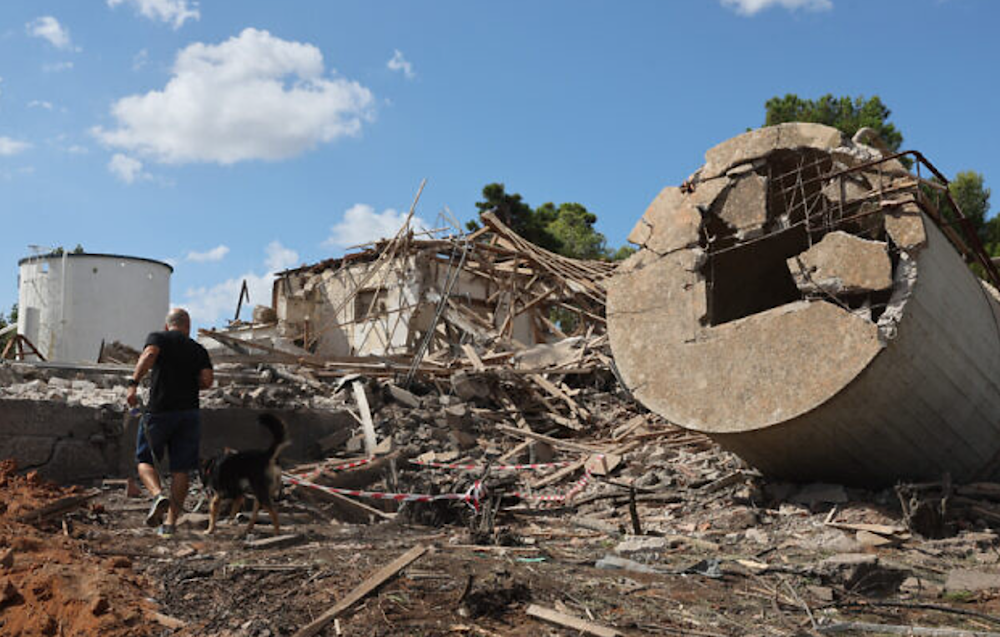WaPo authenticates footage showing Iranian missiles hit 'Israel'
The Washington Post has authenticated videos that showed 20 missiles attacking the Nevatim air facility in the southern al-Naqab desert and three striking the Tel Nof base.
-

An Israeli man walks past the rubble of a destroyed building in Hod HaSharon in the aftermath of Iran's Operation True Promise 2 in the occupied territories on October 2, 2024. (AFP)
On Tuesday night, at least two dozen long-range Iranian ballistic missiles penetrated Israeli and coalition air defenses in Operation True Promise 2, striking or landing near at least three military and intelligence locations, according to an examination of recordings and images of the strike and aftermath.
This should be no surprise -- there is plenty of video showing the missiles raining down on Nevatim. pic.twitter.com/99DaFuP8bs
— Dr. Jeffrey Lewis (@ArmsControlWonk) October 3, 2024
The Washington Post authenticated videos that showed 20 missiles attacking the Nevatim air facility in the southern al-Naqab desert and three striking the Tel Nof base in central "Israel". Analysts told The Post that the images were consistent with direct hits on the facilities rather than debris from intercepted missiles.
Other footage showed at least two missiles crashing near Tel Aviv at Cinema City Glilot, Hod HaSharon, near the Israeli Mossad spy agency headquarters, causing at least two craters.
Read more: IRGC deputy chief: 'We'll target Israel's power, gas if provoked'
The Post's findings suggest Iran was more successful in evading defenses than previously reported. "Israel" claimed its air defenses were successful, but the Pentagon and Israeli military did not respond to The Post's findings, which included three videos showing missiles targeting Nevatim airbase.
A flare is seen in midair as an Israeli interceptor seems to stop an oncoming missile. Fireballs and plumes of smoke rise over the horizon in at least 20 spots where missiles collided with the ground, according to a Post analysis of the 30-second footage, which began after the missiles had left the sky.
Our first count is that 32 missiles struck Nevatim Air Base (pins) -- although three impact points are obscured by clouds in the 50 cm Skysat and had to be made with 3 m Dove images (white pins). @DuitsmanMS @sam_lair @dex_eve @JamesMartinCNS pic.twitter.com/AKxE8g41Vm
— Dr. Jeffrey Lewis (@ArmsControlWonk) October 3, 2024
Jeffrey Lewis, head of the East Asia Nonproliferation Program at California's Middlebury Institute of International Studies, stated that according to his team's estimations, half of Iran's earlier missile launches at Nevatim air base in April fell within three-quarters of a mile of the facility, while the other half fell outside of that radius.
"Israel's" Arrow II and Arrow III are intended to guard against long-range ballistic missiles like the ones used by Iran. Arrow II operates after the missile has entered the last part of its flight, within the atmosphere, whereas Arrow III seeks to intercept missiles still in space, according to Fabian Hinz, an Iran specialist at the International Institute for Strategic Studies in Berlin.
Planet Labs captured medium-resolution satellite data on Wednesday, showing what seems to be at least one demolished structure in Nevatim. Another high-resolution photograph from the base shows a massive hole in the roof of an aircraft hangar, as well as many impact craters.
Lewis said his team counted 32 strikes on Nevatim alone.
A video taken from the balcony of the Hilton hotel in Tel Aviv shows two missiles flying through the sky from the east toward Cinema City Glilot in Hod HaSharon, near Mossad headquarters. One strikes the earth, causing a tremendous flash of light, while the other falls into the water.
We counted! 32 impact points at Nevatim, with a small degree of clustering. They landed multiple hits in the area of F-35 hangers, with one possible direct hit, but not a lot of damage.
— Decker Eveleth (@dex_eve) October 3, 2024
Takeaway: some F-35s got really lucky. https://t.co/n6deA10T7T
A video taken in the aftermath and posted to social media on Tuesday shows a massive hole in the center of a highway, totally blocking traffic. Vehicles nearest to the crash are covered in a thin coating of dirt. Some seem to have had their windows blasted out.
According to video analysis, the missile struck the highway's median, leaving a crater that seems to be around 20 feet broad and more than a dozen feet deep. A Post reporter noticed a second hole on the same route. It was not immediately obvious what type of missiles were utilized in the strike.
Iran's Mehr News Agency stated that Ghadr and Emad missiles were fired, with 90% of them hitting their objectives. The Ghadr and Emad are among Iran's longest-range missiles. Iran also announced it used a Fattah-1 missile for the first time, stating that it can move at high speeds to escape air defenses.
Another video validated by The Post, shows many towers of smoke drifting beyond the horizon line as a result of another missile bombardment on the Tel Nof air base. Bright lights after a missile strike look to be secondary explosions.

 4 Min Read
4 Min Read











